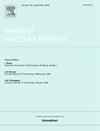Comparative study of 3D-Printable polymers for beta interaction behaviours via monte carlo simulations
IF 2.3
3区 工程技术
Q1 NUCLEAR SCIENCE & TECHNOLOGY
引用次数: 0
Abstract
The rapid advancement of 3D printing technologies has revolutionised production in many sectors due to the versatile properties of printable materials. Thermal, mechanical and functional performance of 3D printable components make them suitable for use in radiation-intensive environments such as betavoltaic cells and clinical phantoms. This study investigates the behaviour of 3D-printable materials, including ABS, PLA, PETG, TPU, and UV resins, under exposure to various beta radiation sources, such as 3H, 63Ni, 14C, 147Pm, 99Tc, 90Sr, and 90Y, through a comparative analysis of their beta radiation attenuation efficiency, energy absorption, and dose transmission characteristics. TPU exhibited a surface flux reduction of approximately 72.3 % for tritium (3H) and 69.8 % for nickel-63 (63Ni) at a thickness of 0.1 µm, demonstrating better attenuation performance for low-energy beta radiation. A new metric, Half Absorption Thickness (HAT), was introduced to quantify the shielding capacity more precisely; the lowest HAT was found for TPU under 3H (0.08 mm), and the highest for PETG under 99Tc (1.12 mm). The derived logarithmic models (R2 > 0.99) enable estimation of shielding efficiency as a function of material thickness and beta energy. Among all tested combinations, ABS exhibited the best attenuation performance against high-energy beta particles, with a maximum flux reduction of 87.1 % for 90Sr and a corresponding HAT of 0.48 mm, establishing it as the most efficient barrier material in the studied energy range. Conversely, UV-cured resin demonstrated the highest beta transmission, particularly under 3H and 63Ni exposure, making it a suitable candidate for applications where controlled dose delivery is desired. These findings contribute to the literature by offering a comparative evaluation of the attenuation performance of 3D printable materials against different beta radiation sources and by providing a basis for material selection in beta applications.
通过蒙特卡罗模拟对三维可打印聚合物β相互作用行为的比较研究
由于可打印材料的多用途特性,3D打印技术的快速发展已经彻底改变了许多部门的生产。3D打印组件的热、机械和功能性能使其适合在辐射密集的环境中使用,如倍他伏打细胞和临床幻影。本研究研究了ABS、PLA、PETG、TPU和UV树脂等3d打印材料在3H、63Ni、14C、147Pm、99Tc、90Sr和90Y等不同β辐射源下的行为,对比分析了它们的β辐射衰减效率、能量吸收和剂量传输特性。在厚度为0.1µm的TPU中,氚(3H)和镍-63 (63Ni)的表面通量分别减少了约72.3%和69.8%,表现出较好的低能β辐射衰减性能。为了更精确地量化屏蔽能力,引入了半吸收厚度(HAT)这一新的度量;TPU在3H时的HAT最低(0.08 mm), PETG在99Tc时的HAT最高(1.12 mm)。导出的对数模型(R2 > 0.99)可以估计屏蔽效率作为材料厚度和β能量的函数。在所有测试组合中,ABS对高能β粒子的衰减性能最好,对90Sr的最大通量降低了87.1%,相应的HAT为0.48 mm,是在所研究能量范围内最有效的阻挡材料。相反,紫外光固化树脂表现出最高的β透射率,特别是在3H和63Ni暴露下,使其成为需要控制剂量传递的应用的合适候选人。这些发现通过对3D打印材料在不同β辐射源下的衰减性能进行比较评估,并为β应用中的材料选择提供依据,从而为文献做出了贡献。
本文章由计算机程序翻译,如有差异,请以英文原文为准。
求助全文
约1分钟内获得全文
求助全文
来源期刊

Annals of Nuclear Energy
工程技术-核科学技术
CiteScore
4.30
自引率
21.10%
发文量
632
审稿时长
7.3 months
期刊介绍:
Annals of Nuclear Energy provides an international medium for the communication of original research, ideas and developments in all areas of the field of nuclear energy science and technology. Its scope embraces nuclear fuel reserves, fuel cycles and cost, materials, processing, system and component technology (fission only), design and optimization, direct conversion of nuclear energy sources, environmental control, reactor physics, heat transfer and fluid dynamics, structural analysis, fuel management, future developments, nuclear fuel and safety, nuclear aerosol, neutron physics, computer technology (both software and hardware), risk assessment, radioactive waste disposal and reactor thermal hydraulics. Papers submitted to Annals need to demonstrate a clear link to nuclear power generation/nuclear engineering. Papers which deal with pure nuclear physics, pure health physics, imaging, or attenuation and shielding properties of concretes and various geological materials are not within the scope of the journal. Also, papers that deal with policy or economics are not within the scope of the journal.
 求助内容:
求助内容: 应助结果提醒方式:
应助结果提醒方式:


